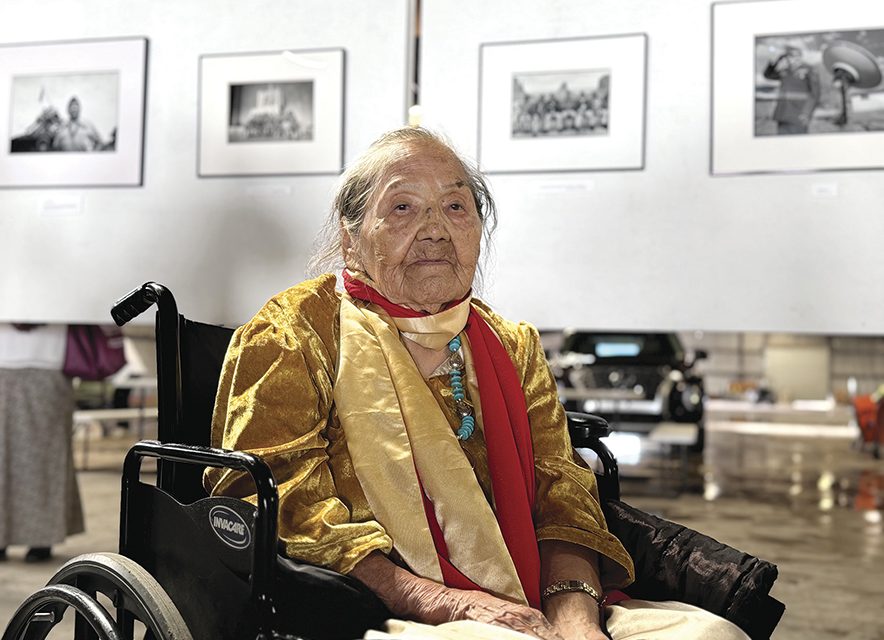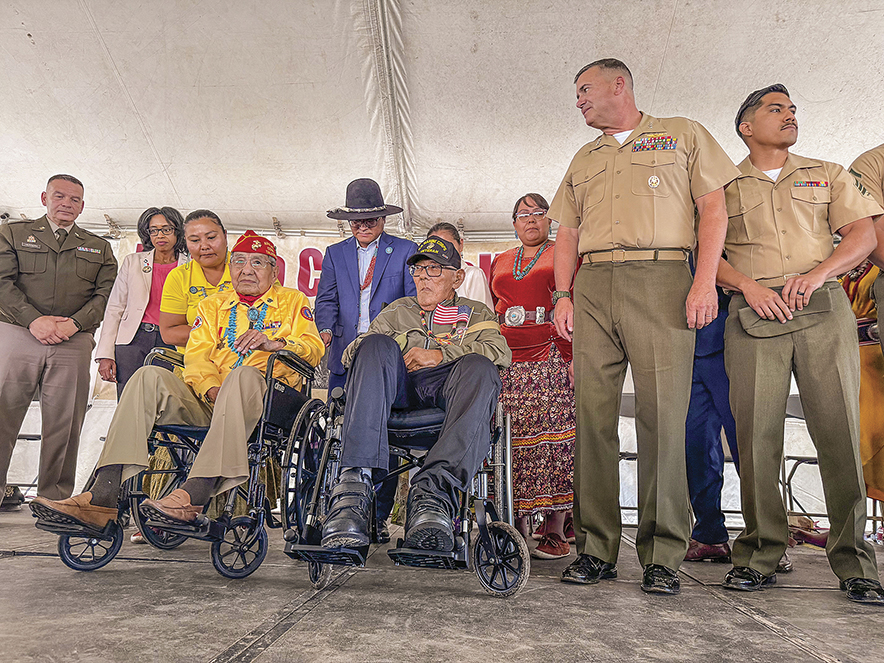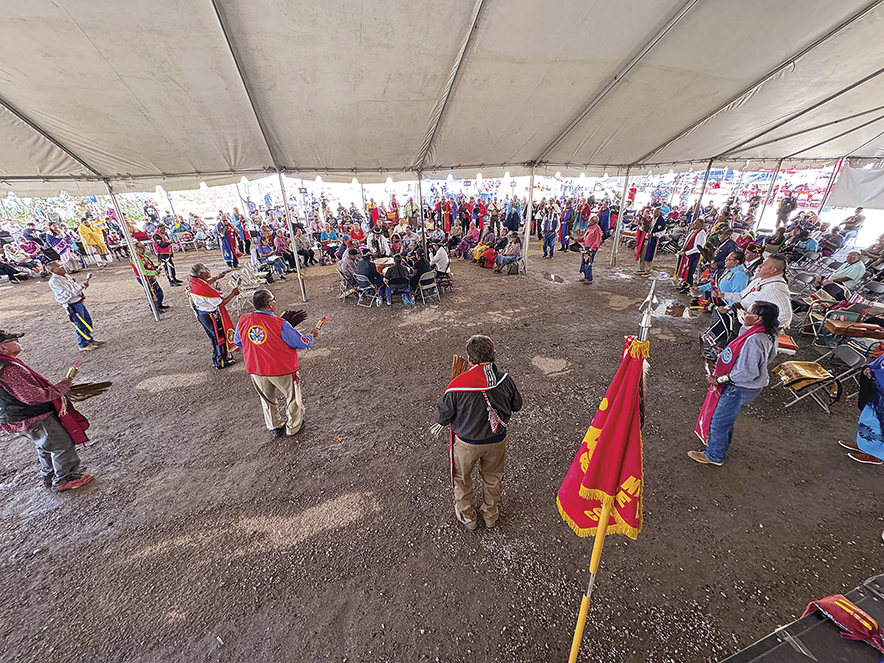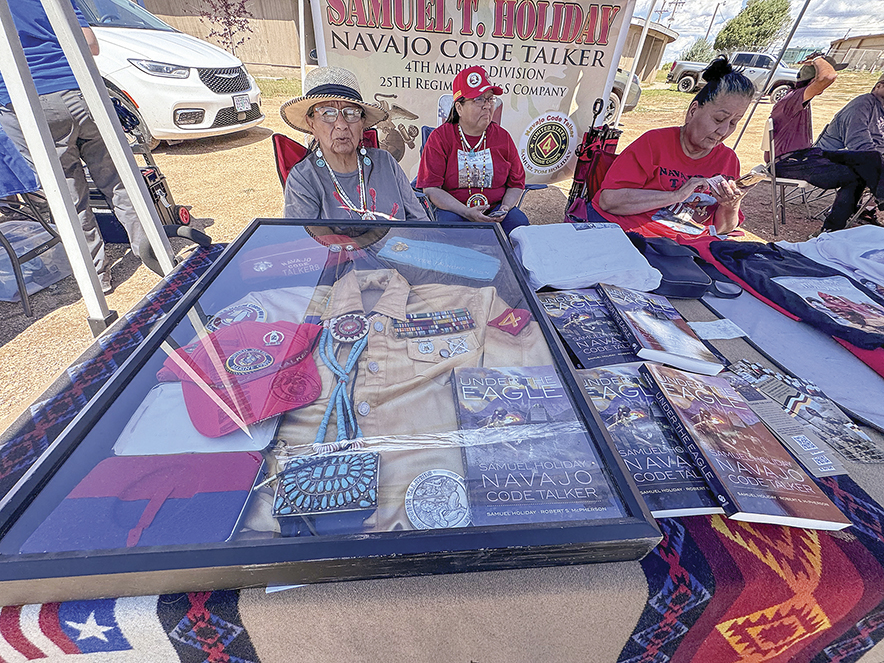
National Navajo Code Talkers Day: Navajo Code Talkers honored in Tségháhoodzání

Special to the Times | Donovan Quintero
Widow of the late Navajo Code Talker Sydney Bedoni, Lena B. Bedoni, sits inside Nakai Hall on National Navajo Code Talker Day in Window Rock. Bedoni said she did not know her husband was a code talker, with whom she was married to since 1951.
By Donovan Quintero
Special to the Times
WINDOW ROCK — National Navajo Code Talker Day was celebrated on Wednesday at the Navajo Nation Fairgrounds.
The annual National Navajo Code Talkers Day drew hundreds of attendees to the Navajo Nation capital on Aug. 14, as the community came together to honor the remarkable legacy of the Navajo men who developed a unique code using their native language during World War II.

Special to the Times | Donovan Quintero
Marine Corps and World War II veteran Cpl. Peter MacDonald Sr., who completed the combat communication school, bottom right, and Vietnam War veteran Henry Tsosie, left of MacDonald, pose for photos along with Navajo Nation President Buu Nygren and Speaker Crystalyne Curley on National Navajo Code Talkers Day in Window Rock.
Lena B. Bedoni, a wheelchair user, attended the annual event with her son Darrell Bedoni, to honor his late father Navajo Code Talker Sydney Bedoni from White Cone, Arizona.
Darrell said his father didn’t share too much of his days in the U.S. Marine Corps until he was invited to attend the parade in Philadelphia in 1976.
“But when he told us, they started going to parades, one of the biggest parades we went to was the year of 1976 over in Philadelphia,” Darrell remembered of his father. “So, we were able to go to Washington, D.C. So, they were in that parade of the bicentennial.”
He said his mother didn’t even know her husband of 63 years was a code talker.
“And then my mom didn’t even know when they were married all that time,” he said.
Lena said despite her memories of their marriage not being as sharp as it used to be, remarked that her husband did eventually tell her what he did in the Marine Corps.
The couple had two girls and one boy, Lena said. Overall, they have 18 grandkids. Lena spent her time looking at photos of other Navajo Code Talkers families brought with them.
This year’s event was particularly poignant, as it honored three of the remaining code talkers: Thomas H. Begay, John Kinsel Sr., and Peter MacDonald Sr., who trained to become a combat communications operator as the war neared its end with Japan’s surrender on Aug. 15, 1945.
Critical role of code talkers
The ceremony began with a procession, led by motorbikes that began from the Navajo Nation Veterans Memorial Park and ended at the Navajo Nation fairgrounds. After the procession, speeches, highlighting the critical role the code talkers played in the U.S. military’s efforts in the Pacific Theater were held under a tent at the fairgrounds.

Special to the Times | Donovan Quintero
Gourd dancers form a loose circle as they dance to honor code talkers on National Navajo Code Talkers Day in Window Rock.
Their innovative use of the Navajo language created an unbreakable code that was instrumental in the success of numerous operations, ensuring secure communication that significantly contributed to the Allied victory.
“We call upon all citizens to celebrate the sacred Diné language as a living language for future generations of Navajo people,” he said entirely in the Navajo language. “Let us never forget the sacrifice of our Navajo Code Talkers. Without them, most of us would not be here today.”
The event included a gourd dance and displays showcasing the history of the code talkers. Attendees were encouraged to engage in discussions about the importance of preserving the Navajo language and culture, which were crucial to the code’s success.
As the day progressed, MacDonald arrived, after being greeted by admirers, he was lifted with a wheelchair by a squad of Marines onto the stage where he gave a historical perspective of the legendary Navajo Code Talkers.
‘Enemy could not duplicate’
“In Iwo Jima landing, over two hundred Navajo Code Talkers participated on the Iwo Jima landing,” said MacDonald. “So, I want to thank all of you here today to honor those over four hundred who were special additions to the United States. It is true, Navajo Code was a weapon, a weapon that an enemy could not duplicate.”
MacDonald said the Navajo code was first tested on Aug. 7, 1942, on the beaches of Guadalcanal.

Special to the Times | Donovan Quintero
Family of the late Navajo Code Talker Samuel Holiday, daughter Helena Begay, left, granddaughter TJ Begaii, middle, and daughter Lupita Holiday, sit with their father’s Navajo Code Talker uniform on National Navajo Code Talker Day in Window Rock.
“The Navajo Code was tested in actual battle to make sure that under enemy fire we can remember because the code that was developed was subject to memory only,” he said, explaining that code talkers were not permitted to write the codes down. “We were told not to do that because if the enemy shoots you, they search and they see the code, they’ll break the code.”
During World War II, around 44,000 Native Americans enlisted to serve in the military, with 723 of them becoming United States Marines. Notably, over 400 of these individuals were Navajo Code Talkers, who would play a crucial role in the war.
In May 1942, according to MacDonald, the first group of 29 Navajo Marine recruits, arrived at Camp Elliott near San Diego, California, to develop a Navajo code for military use. The recruits created a system by associating words from their language with military terminology.
The initial code featured 211 terms, which expanded to 411 throughout the war. During the invasion of Iwo Jima, six Navajo Code Talkers operated continuously, successfully transmitting over 800 error-free messages.
Their contributions earned them deep respect from fellow Marines. Maj. Howard Connor, the signal officer during the campaign, remarked that the Marines might not have taken Iwo Jima without them.
Navajo Code Talkers Day
However, the significance of their work remained unrecognized until the operation was declassified in 1968. In 1982, President Ronald Reagan honored the code talkers by declaring August 14 as “Navajo Code Talkers Day” and awarding them a Certificate of Recognition.
Subsequently, in 2000, President Bill Clinton signed legislation to award the Congressional Gold Medal to the original 29 Code Talkers, with President George W. Bush presenting the medals to the four surviving members during a ceremony at the Capitol Rotunda in July 2001.
Joining the president for the signing of the proclamation was Arizona Representative Eli Crane, Navajo Nation Council Speaker Crystalyne Curley, Chief Justice JoAnn Jayne, and Lt. Gen. Michael S. Cederholm, the Commanding General of the 1st Marine Expeditionary Force.
There are three surviving members of the Navajo Code Talkers: Thomas H. Begay, 99, John Kinsel Jr., 107, and Peter MacDonald Sr., 96.
The commemoration concluded with a gourd dance, honoring the legacy of the Marines and veterans alike.
Kinsel, who did not attend, recently celebrated the renovation of the home he built after returning from the war. Begay, who also did not attend, was recognized during the 21st Annual Native American Basketball Invitational in July which he attended.








 Highway 264,
Highway 264, I-40, WB @ Winslow
I-40, WB @ Winslow